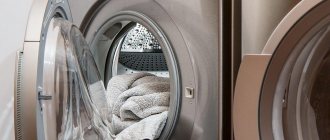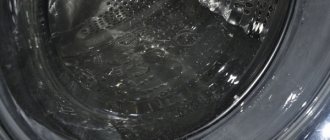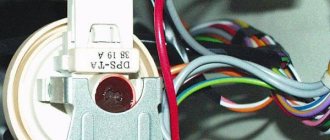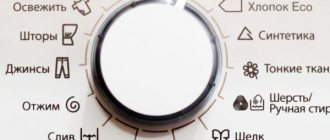Published: 14 Oct 2020
Although advertising promises with all its might that the washing machine operates silently, in reality this is not the case. SMA is a complex household appliance, some of its parts move and rotate, and therefore make noise. This is the sound of normal operation, but sometimes owners notice that something is knocking loudly inside the washing machine. It can rattle in different ways:
- a knocking sound appears during washing or is heard during the spin cycle of the washing machine;
- The knocking sound in the washing machine is heard only in the spin mode.
What to do if you hear unusual knocking sounds? First you need to exclude external causes.
The most common causes of extraneous noise
There is nothing particularly complicated in the design of a washing machine. Therefore, there are not so many places where a malfunction can nest. It all depends on at what stage of washing the unusual noise and rattling occurs. The reasons why a loud noise is heard may be as follows:
- The bearing installed in the drum drive has become unusable.
- The mounting bolts holding the tank in place during transportation were not removed.
- The drive pulley is loose.
- The counterweights holding the drum are loose or crumbled.
- Some small objects got between the drum and the wall of the tank and got stuck there.
- The drain pump is broken.
- The rubber seal located on the hatch cover has crumbled or does not fit properly.
- The washing machine is not installed level.
See also -
Why does powder remain in the washing machine tray after washing?
Call the master
Replacing a drum costs at least 3,500 rubles, excluding expenses for the part itself. Work completion time is from 1 to 3 hours. The average warranty period is 1 year.
When calling a specialist, you need to contact trusted specialists . It is recommended to give preference to repairmen from a large company that has its own website and office in the city.
To minimize the risk of encountering scammers, you first need to study reviews about the company on the Internet. Contacts of masters can be found on the Internet or in newspaper advertisements.
Bearings are damaged
This is a fairly complex breakdown that will require some skill to fix. But it’s not difficult to find it. You need to disconnect the washing machine from the network and spin the drum, pressing lightly on it. First twist clockwise, then counterclockwise. If the movement is intermittent, you hear a whistle, knocking and grinding noise - you can rest assured that the problem is in the bearings.
There is another way to detect the problem. The fact is that a leaky seal leads to bearing damage. When it is damaged, water gets in further and the bearing rusts and crumbles. You can see this by unscrewing the back panel. With such a malfunction, rusty streaks usually appear in the middle part of the tank.
If the cause is found, it must be corrected as quickly as possible.
Operating a washing machine with crushed bearings ends in damage to the bushing and shaft on which the drum sits. All this only aggravates the problem and increases the cost of repairs. See also:
A bra wire got into the washing machine
Professional solution to the problem at the Tandem service center
If you have tried to fix the problem, but the washing machine continues to knock, try contacting Tandem for advice. Service center specialists will conduct an initial consultation over the phone. Sometimes during the consultation the problem resolves itself. And if not, you can always call a specialist to your home.
For a professional technician, such breakdowns are a common occurrence. We know what and how to do to fix the problem. The advantages of the company are affordable prices, cost calculations that do not change during the renovation process, discounts for pensioners, as well as various promotions. All work is guaranteed for 2 years. It is confirmed by a warranty card, which is issued by the technician after repairing the washing machine.
Transport bolts
For more careful transportation, special fastening bolts are provided in the washing machine body. They fix the shock-absorbing springs and prevent the tank from dangling from side to side. If the fasteners are not removed after installing the unit, the drum will rotate with a loud knock. What to do?
The problem can be solved very simply. You just need to unscrew the mounting bolts. The noise will stop. They are located in the back wall of the machine. By the way, this is written in great detail in each installation and operating instructions.
How to avoid trouble
What should the owner of a washing machine do to prevent it from making noise, rattling, crackling, rattling, creaking, vibrating, and also making beating, rustling, whistling, grinding and humming noises during operation for as long as possible? Everything ingenious is simple:
- First, carefully read the operating instructions;
- carefully follow all manufacturer's recommendations;
- Correctly assess your capabilities and seek help from professionals in case of complex breakdowns.
Following these three recommendations will be enough to prevent your washing machine from breaking down.
The pulley is loose
When the washing machine hums, makes noise and clicks loudly when the drum rotates, the problem may be that the drive pulley is weakening.
This is easy to check. Turn on the machine in test mode. If this is not the case, a hand wash mode or any other mode in which the drum rotates slowly will do. Listen carefully to the sound while looking at the drum. If every time you turn it you hear an extraneous noise, or rather a clicking sound, the pulley is most likely to blame. It's easy to fix the situation. Remove the back panel and locate the mounting nut that holds the pulley in position. Using a wrench of the appropriate size, eliminate the play by tightening the nut until it stops. If the noise during rotation disappears, then you did everything right. If not, we continue searching.
Counterweights
These rather heavy elements of the washing machine hold the unit's tank in place during the spin cycle. They are designed to dampen centrifugal force and counteract the rocking of the washing machine. If you hear a loud noise or rather a rattling noise when spinning the drum, check the counterweights. They are made of concrete, and it tends to deteriorate from old age.
Unscrew the back panel of the washing machine and carefully inspect the counterweights, shake them.
If the fasteners are loose, they need to be tightened by tightening the corresponding bolts tightly. If you find cracks on any of the counterweights, it is better to replace it completely. If this is not done, strong vibration may cause the counterweight to crack and damage the insides of the unit. Then you will have to repair a lot more. See also -
Shock absorbers for washing machines: do-it-yourself repair and replacement
Garbage and foreign objects
If you hear an unusual ringing, noise or grinding sound during washing or spinning, the reason may be that some foreign object has entered the tank. This often happens when housewives do not check their pockets very carefully. Such items can be nuts, coins, paper clips, bra underwires, metal buttons, and so on. What to do? How to eliminate extraneous noise?
We'll have to tinker. In order to look into the tank, you need to get to the heating element and unscrew it. Through the resulting hole, using long tweezers or just your fingers (if possible), remove objects that make an extraneous sound. Now you need to put the heating element in place, not forgetting to clean and degrease the rubber seal. It can be lubricated, for example, with liquid detergent.
Sometimes the problem can be solved much easier. Some models of “washing machines” have a special sump in which a filter is installed. In this case, you just need to open the sump door. It is most often located in the front. Now we just take out the filter and shake out everything that gets into it.
The laundry inside the drum is unevenly distributed
This problem often affects early models. The clothes bunch up in a big ball and hit the body during the washing process. As a result, an imbalance appears. To correct the situation, you need to pause the washing program and lay out the laundry more evenly. It is worth mentioning that new models from Indesit, Ariston, Samsung, LG and others do not have such problems.
Faulty pump
Sometimes, when the washer hums and makes noise while draining water, the reason may be that the drain pump is damaged. You can try to correct the situation by cleaning the strainer. It is located on the front side of the unit, behind a special cover.
You also need to make sure that the drain pipe is clean. This is another reason why the machine began to make noise. Clean the pipe, it is likely that the noise will disappear.
If nothing helps and the unit still hums and rattles, things are bad. The drain pump has completely failed and will have to be replaced. To avoid mistakes, listen carefully to the operation of the unit. You can “suspect” the pump only if the “washing machine” makes noise only when filling or draining water, and the rest of the time it works quietly. The sound will be very similar to the noise of a running transformer.
Rubber compressor
It happens that during operation, and especially during spinning, the washing machine whistles.
In this case, you find rubber shavings on the cover or walls of the hatch. Most likely it's the seal. This most often happens with inexpensive models of washing machines. Of course, it is best to replace the seal and choose a new one that fits in size. But you can try to solve the problem with the help of advice from folk craftsmen. Take a small piece of sandpaper and insert it between the front wall and the rubber seal. Now run any wash cycle that is at least half an hour long. There is no need to put laundry down. Sandpaper will help you adjust the elastic to size. All you have to do is take it out and remove the rubber debris from the machine. To do this, run an additional rinse cycle and then clean all filters.
DIY machine repair
To repair a machine yourself, you need to know its structure and operating principle. As a rule, repairs involve replacing old parts with new ones. When troubleshooting, you must first disconnect the machine from the power supply.
To replace parts yourself, you need to have a standard set of tools, and to repair the control board or electronics, you may also need a soldering iron.
The first thing a washing machine owner can do is clean the filter. It often happens that small items of clothing or threads get there, which subsequently prevent the water from draining from the washing machine. To do this, you need to open the small cover located at the bottom of the machine and unscrew the small plastic plug using pliers.
After this, you need to clean the filter and rinse it under running water.
This filter is located in the water intake hole. It can become clogged with small particles of dust or sand. To do this, you need to unscrew the inlet hose and use pliers to pull out the filter - a small plastic mesh that needs to be rinsed under water.
Replacing the heating element
If the repair involves replacing the heating element, you must first remove the back cover of the machine. Then disconnect the terminals and use a multimeter to check the element for functionality. The faulty heating element must be unscrewed using a wrench. After the old heating element is removed, you need to replace it with a new one. Be sure to install all parts in the correct order.
These are the most common types of repairs that you can easily carry out yourself. For more serious damage, it is better to contact a specialist.
Incorrect installation of the washing machine
Sometimes the answer to the question why a home laundry machine rattles and rattles during washing, especially during the spin cycle, is that it is simply not installed correctly. We are not talking about the electrical part here, but simply about its physical location. If the unit is not installed level, then when rotating at high speeds, for example, during a spin cycle, the centrifugal force will unbalance it. This leads to the following consequences:
- strong vibration is observed;
- the body of the car sways or “jumps”, moving from its place;
- A strong knocking and beating of the drum is heard.
To correct the situation, nothing needs to be repaired. All you need to do is set the washing machine level by tightening the legs. The sound should disappear.
If, after checking all the reasons described above, you still have not found the reason why the washing machine makes unusual sounds, the problem may be in the electric motor or the “wired” part of the unit. You can’t do this without special skills. It's best to call a professional. Using a multimeter, he will carefully “ring” all suspicious places and determine the cause of the hazing sounds.
Tips for avoiding malfunctions
- Observe the permissible load during washing - leave the drum one third empty.
- Perform preventative cleaning between work cycles.
- Try to use programs with high water heating as little as possible.
- Open the door after each wash to allow the machine to dry.
- If you wash several times a day, take breaks of 30 minutes.
- Leaving the washing machine idle for a long time causes the lubricant to evaporate and dry out.
- For budget models, components quickly wear out or wear out.
- Follow the rules for transportation, installation and connection to communications.
Watch the video about why the washing machine is noisy
Prevention
In order to invite a technician into your home as little as possible, it is enough to follow simple rules for operating the washing unit. This will not only extend its service life, but also save you from unnecessary hassle. What are these rules?
- Do not overload the machine. It is better to put a little less laundry in it than required according to the instructions.
- Try to do laundry no more than once a day. This will avoid additional stress on the parts. The washing machine will have time to cool down and dry thoroughly.
- Clean all possible filters regularly. You can also install additional water purifiers if necessary.
- Clean your machine from limescale deposits more often. Use special tools for this and follow the instructions.
- If possible, run the boiling program and spin mode at maximum speed as often as possible. If you do this often, components and parts will fail much faster.
- Before putting things in the machine, do not forget to carefully inspect the pockets and folds. Keep buttons and zippers fastened, and use a special bag for washing bras. All these precautions will save you from “fishing out” small objects from the bottom of the drum.
And remember: you shouldn’t delay the repair of the “home laundry”. If you ignore the problem at the initial stage, the matter may worsen and then the repair will cost much more.
See also:
- 10 Best Top Loading Washing Machines
- 10 best Hotpoint-Ariston washing machines according to customer reviews
- 10 best Electrolux washing machines according to customer reviews
- 10 best ATLANT washing machines according to customer reviews
- 10 best built-in washing machines











